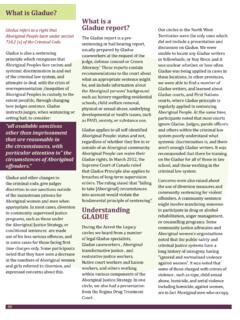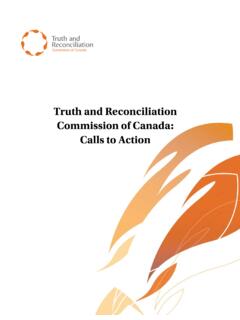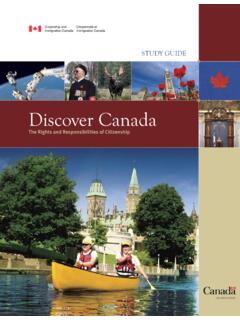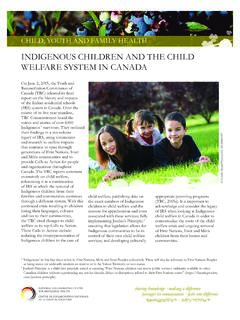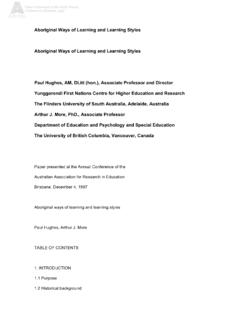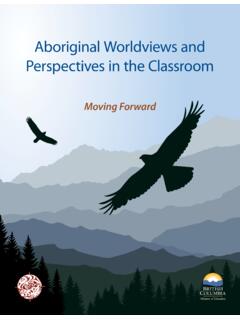Transcription of The Native Women’s Association
1 Ur Head Office 85 Albert Street, 12th Fl oor, Ottawa, ON K1P 5Y9 Tel: (613) 722-3033 Fax: (613) 722-7687 Toll-free: 1-800- 461- 4043 The Native Women s Association Fact Sheet: Violence Against Indigenous Women, Girls, and 2 SLGBTQQIA PEOPLE IN canada Oct ober 2020 | Page Rates of Violence: Indigenous women and 2 SLGBTQQIA people face life-threatening, gender-based violence, and disproportionately experience violent crimes because of a genocide based on sexism and racism. This fact sheet places the issue of missing and murdered Indigenous women and 2 SLGBTQQIA people in the broader context of violence against Indigenous women and 2 SLGBTQQIA people.
2 By understanding the severity of the issues, we can better work toward breaking the cycle of violence. For years, communities have pointed to the high number of missing and murdered Indigenous women, girls , and 2 SLGBTQQIA. Indigenous women are more likely to report experiencing both physical and sexual maltreatment as a child than Indigenous men (14% versus 5%) and are three times as likely to report being a victim of spousal violence as non-Indigenous women (Boyce, 2016). Statistics canada has found that even when controlling for other risk factors, Indigenous identity itself remained a risk factor for violent victimization of women which was not found for men (Boyce, 2016).
3 Indigenous LGBTQ2S+ individuals also experience a high rate of physical and sexual violence (Holmes & Hunt, 2017). Distinct Impacts of Global Pandemic, COVID-19, on Rates of Violence Based on a national survey that NWAC undertook from May 1 to May 29, 2020, a sample of 750 Indigenous women and gender-diverse people to measure the impact of the global pandemic crisis on Indigenous women in canada . The survey highlighted: 1. Indigenous women are more worried about domestic violence than they are about most COVID-19 issues . 2. Many more Indigenous women are experiencing violence during this pandemic than usual. Indigenous women are reporting more violence during this time of sheltering in place.
4 In May 2020, 17% have experienced violence (physically or psychologically) in the past three months, compared to 10% reporting violence from their spouse over the past five years in 2014. 3. Indigenous women most vulnerable to violence in the past three months are in the North, under 35, and have been financially impacted by COVID-19. 4. Romantic partners are overwhelmingly seen as the biggest source of violence. 5. The financial impact of COVID19 is strongly correlated to violence against Indigenous women. A majority (70%) of the women and gender-diverse people who are moderately or majorly impacted financially by COVID-19 have experienced violence in the past three months.
5 Similarly, women under 35 are also hit especially hard financially, which is also probably contributing to their higher rate of violence. Missing and Murdered Indigenous Women, Girls, and 2 SLGBTQQIA People For more than four decades, the Native Women s Association of canada (NWAC) has worked to document the systemic violence impacting Indigenous women, their families, and communities. From 2005 to 2010, NWAC s Sisters In Spirit (SIS) Initiative confirmed 582 cases of missing and/or murdered Indigenous women and girls over a span of twenty years and worked to raise awareness of this human rights issue. NWAC s research indicates that homicides involving aboriginal women are more likely to go unsolved.
6 2 | Page Only 53% of murder cases in NWAC s Sisters In Spirit database have been solved, compared to 84% of all murder cases across the country. From 2010 to 2014, NWAC continued to raise awareness and engage with communities through the culture-based and the creation of a comprehensive Community Resource Guide with the Evidence to Action projects. Throughout our work, NWAC believed the violence against Indigenous women to be much more pervasive than publicly available data would indicate. This suspicion was confirmed in 2013, when the RCMP released a report revealing 1,181 cases of missing and/or murdered Indigenous women and girls. The 2015 update document now unavailable on the RCMP s website added 19 female aboriginal missing cases, for a total of 174 aboriginal females missing for at least 30 days as of April 1, 2015.
7 In December 2015 the Government of canada launched the National Inquiry into Missing and Murdered Indigenous Women and Girls (MMIWG). Its final report, Reclaiming Power and Place: The Final Report of the National Inquiry into Missing and Murdered Indigenous Women and Girls, includes 231 individual Calls for Justice directed at governments, institutions, social service providers, industries, and all Canadians. The National Inquiry confirmed that, rates of violence against Metis, Inuit, and First Nations women, girls, and 2 SLGBTTQIA people are much higher than for non-Indigenous women in canada , even when all over differentiating factors are accounted for.
8 Perpetrators of violence include Indigenous and non-Indigenous family members, partners, casual acquaintances, and serial killers (Executive Summary, 2019 p. 3). Community-based research has found levels of violence against aboriginal women to be even higher than those reported by government surveys. There are many limitations to government-collected statistics. Government statistics are based on police-collected data, but police numbers reflect only those incide nts that are reported to police. Six out of 10 incidents of violent crime against Indigenous people are thought to go unreported. There are no standard policies covering whether and/or how police track violence experienced by Indigenous peoples.
9 Some police agencies, including the RCMP, do not collect this information at all. This is significant, as the RCMP covers 75% of canada s geography and serves more than 630 aboriginal communities. There is no requirement or consistent protocol regarding how police gather information on Indigenous identity. NWAC honours community reporting as the most reliable means of knowing whether a particular women or 2 SLGBTQQIA person is Indigenous. Police recording, meanwhile, is often based on the visual assessment of the woman by the officer involved Data from the RCMP are shared with the National Centre for Missing Persons and Unidentified Remains (NCMPUR), which will work to publish these cases on its canada s Missing website.
10 T he problem, however, is that NCMPUR s Fast Fact Sheets from 2015-2019 do not disaggregate by race/ethnicity (this website s statistics disaggregate only by province, sex, and probable cause). NWAC holds the only national database on the number and circumstances of missing and murdered aboriginal women and girls in canada . For more information, please see consult our website for Violence Prevention and MMIWG 3 | Page References Amnesty International canada . (2004). Stolen Sisters: Discrimination and violence against Indigenous women in canada . Ottawa: Amnesty International. Boyce, J. (2016). Victimization of aboriginal people in canada , 2014.
